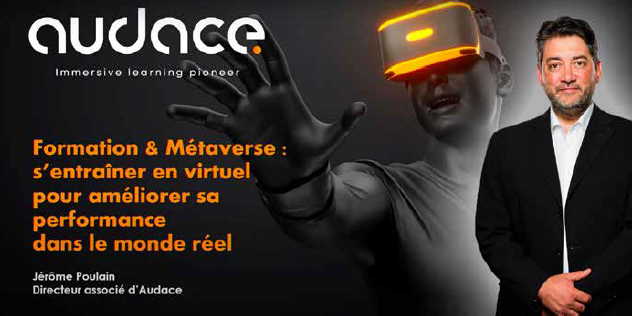On May 16th, AUDACE participated in the seminar “The Metaverse is Dead, Long Live the Metaverse” organized by the Aristote association at the premises of École Polytechnique in Paris Saclay. AUDACE was able to share its experience with the Metaverse during a Use Case dedicated to the use of this type of platform in professional training.
Despite its young age, the Metaverse already wears a cloak of shadows and speculation. Like the phoenix, the Metaverse disappears and reemerges, always more fascinating and promising. How can we ensure the long-term sustainability of this type of platform? How can we make it efficient for professional use, especially in training?
The Metaverse: A constantly evolving virtual universe.
The concept of the Metaverse refers to an online virtual world that provides a shared and persistent digital space where users can interact and engage in various activities. It is often described as a space where the boundary between the real world and the virtual world becomes blurred, integrating elements of virtual reality, augmented reality, online gaming, and online social networks. Users are represented by avatars and can contribute to the creation of content and the evolution of the virtual environment.
The history of the Metaverse dates back to ideas and concepts that have emerged over the decades. Neal Stephenson popularized the concept in his science fiction novel “Snow Crash” in 1992, depicting a virtual world called the “Metaverse.” The early incarnations of the Metaverse can be found in the virtual worlds and massively multiplayer online games of the 1990s and 2000s. The emergence of immersive devices such as VR and AR headsets has brought new perspectives to the development of the Metaverse.
Closely linked to the Metaverse, video games contribute to its popularity.
The future of the Metaverse: Virtual meetings, digital economy, and ethical challenges.
As for the future, the Metaverse’s future is constantly evolving and generating increasing interest. It could become a virtual meeting place for people from all around the world. Furthermore, it facilitates the digital economy with commercial opportunities and virtual marketplaces. Lastly, it stimulates creative and cultural collaboration. However, it also raises challenges and ethical questions. These challenges include privacy protection, online security, and content regulation.
That is why the development of the Metaverse depends on several key factors, such as technological advancements and investments from companies. It is also important to consider user adoption, interconnectivity, and standardization. Lastly, there are virtual economy and monetization considerations, as well as regulations and legal frameworks.
Towards immersive and collaborative learning...
In the professional domain, the Metaverse can be used to enhance remote meetings and collaboration. It can also be employed for training, learning, and creating virtual workspaces. For businesses, it is even more relevant for organizing professional events, data visualization, and modeling. Finally, it can also be involved in business-to-business commerce.
Specifically in terms of education, the Metaverse goes beyond immersive learning. It promotes immersive and collaborative learning. Learners can practice with colleagues from around the world in the Metaverse. They can also work with a trainer on a digital twin, solve problems, and share ideas, regardless of their geographical location. They can also benefit from multi-user simulations of work situations and interact with each other without taking risks. Audace has already had the opportunity to successfully develop initial Metaverses for companies like Orano and AFTRAL.
In conclusion, the Metaverse is an ever-evolving concept that offers a potential for innovation and transformation in various fields, from the gaming industry to the digital economy and professional training. Its future will depend on technological advancements, user adoption, corporate investment, and the establishment of appropriate regulations.

